 Originally established to eliminate architectural barriers for those with accessibility requirements, educators have recognized universal design as a strategy that can be used to address individual learning styles. Universal Design for Learning (UDL) provides a framework for course structure, individualized instruction, assessment, and academic engagement. Universal Design for Learning has the potential to maximize learning opportunities for all.
Originally established to eliminate architectural barriers for those with accessibility requirements, educators have recognized universal design as a strategy that can be used to address individual learning styles. Universal Design for Learning (UDL) provides a framework for course structure, individualized instruction, assessment, and academic engagement. Universal Design for Learning has the potential to maximize learning opportunities for all. The following are a few applications available for the iPad, iPod or iPhone that can help support a UDL-based learning environment:
| Application | Description | Potential Use |
| 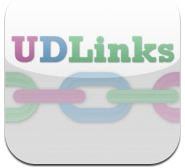
| UD Links Apple App Store Description: “This app is for teachers and parents to search for content specific online teaching resources aligned with Universal Design for Learning. Users can complete a "Class Profile" narrowing the resources by content, grade level and topic. When prompted, questions in the profile tool narrow the search further by asking questions aligned with UDL. In the resources section of the app, teachers can search for lesson plans, multimedia, practice, games, tutorials or by topic and unique search terms. As users navigate the resources, they can save as favorites, share and view on their mobile device. The app also has a section for Universal Design for Learning linking teachers and parents with resources shared directly on the CAST website.
This app was developed as a product of the College and Career Readiness Support Project, a federal ARRA Title-II-D Ed Tech partnership grant, in collaboration with the Maryland State Department of Education.” | This application can serve as the initial point of reference for guidance in the design and development of UDL-based courses, lesson plans, and the use of web 2.0 tools. |
| 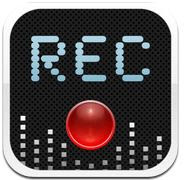
| Voice Memos Audio recording application for the iPad. | This application can be used to record classroom lectures. The content can then be uploaded to a server for distribution, providing an alternate means for delivering content. Students are able to watch the video as often as necessary to understand content being delivered. Can be used by students who experience difficulty with writing or recall. |
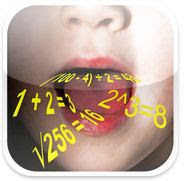 | Talking Calculator The application speaks button names and calculation results aloud with either a built-in or custom recorded voice. | Can be used in support of math comprehension, assisting students with math-related learning difficulties, as well as students with visual challenges. The audio can also reinforce student comprehension of numeric elements. |
| 
| iPad Settings The iPad device natively supports accessibility in a variety of ways, which are configured via the “Settings” application. Options include: - VoiceOver
- Zoom
- Large Text
- White on Black
- Speak Selection
- Speak Auto-Text
- Mono Audio
- AssistiveTouch
- Triple-Click Home
- Brightness of Page
- Font Sizing
| Supports learners with visual, hearing, or motor challenges. These settings are global in nature and can be used to assist learners in a variety of settings accessing a variety of learning modules. For example, students experiencing visual difficulties could use the “large text” feature when using Internet-based learning management system-based courses. |
| 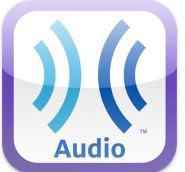
| Learning Ally Audio App for the iPhone, iPod Touch, or iPod. Access downloadable DAISY-formatted audiobooks. | Serves individuals with visual impairments or learning disabilities who experience difficulty with reading printed material. The DAISY format allows users to hear and navigate written material presented in an audible format. |
| 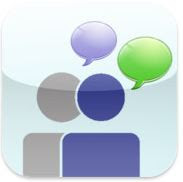
| Assistive Chat An Augmentative Alternative Communication Device. Allows users to communicate at the fastest rate possible, using natural sounding voices. | For individuals who experience difficulty in the area of speech. This technology could be used in support of group discussion or group project assignments. |
| 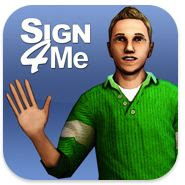
| Sign4Me An avatar provides sign language instruction in 3D, from selectable vantage points. The library includes over 11,500 words. | Can be used to create supplemental sign-language based course content for those with hearing challenges. |
| 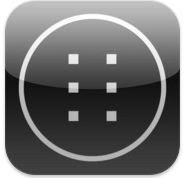
| TypeInBraille Allows the user to write in Braille on an iPhone. Braille files may be delivered to others via email and text message. | Can assist instructors in the creation of Braille-based content that can be distributed to students via email or text messaging. |
| 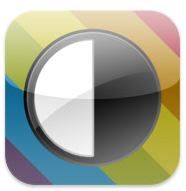
| ContrastAnalyst Allows the user to calculate the contrast ratio between two colors, ensuring compliance with accessibility guidelines | Assists instructors with the appropriate selection of colors to assist those who may experience difficulty with color contrast. |
| 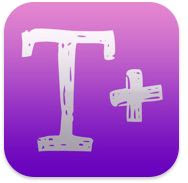
| Text Enlarger HD Allows the user to type in desired text and enlarge it to the biggest size possible. Maximum font size is 620. | Effective for hearing or speech impaired individuals. |
| 
| NotesPlus Handwriting, Note Taking, Typing, Drawing and Sound Recording Application | This flexible application provides multiple means for capturing information based on the student’s preferred method. For example, during lectures, students who experience motor difficulty impacting writing could create audio recordings to be reviewed or shared at a later date. |
 Originally established to eliminate architectural barriers for those with accessibility requirements, educators have recognized universal design as a strategy that can be used to address individual learning styles. Universal Design for Learning (UDL) provides a framework for course structure, individualized instruction, assessment, and academic engagement. Universal Design for Learning has the potential to maximize learning opportunities for all.
Originally established to eliminate architectural barriers for those with accessibility requirements, educators have recognized universal design as a strategy that can be used to address individual learning styles. Universal Design for Learning (UDL) provides a framework for course structure, individualized instruction, assessment, and academic engagement. Universal Design for Learning has the potential to maximize learning opportunities for all. 










Marty- Isn't it amazing how many apps are out there that can be utilized with any type of learner? I also looked at apps for use on the iPad and found myself wishing I actually had an iPad to try them on. Did you get to try any of them out? Which ones do you think would work in your environment you work in? I know that many of them are for education but I feel that they could be utilized anywhere to fit the needs of fellow co-workers. Maybe I'm wrong:) I appreciated your applications and liked the color contrast app that you mentioned. I know lots of individuals who could benefit from this app.
ReplyDeleteThis is an excellent list of apps, Marty! I hadn't thought about it until now, but it must be difficult for visually impaired persons to type on an iPad since there aren't any physical keys. Or is there an iPad setting that remedies that?
ReplyDeleteInteresting list! I have a question about the voice memo app. I typically do not let my students record my lectures without prior permission from me for similar reasons to those we use plagiarism policies for. Would this be an issue in a k-12 class as well?
ReplyDeleteThis comment has been removed by the author.
ReplyDeleteMarty, you've assembled quite a collection of applications for the iPad. It's quite impressive. I believe the variety of applications that have been developed is in large part to the diversity of learners.
ReplyDeleteThis comment has been removed by the author.
ReplyDelete